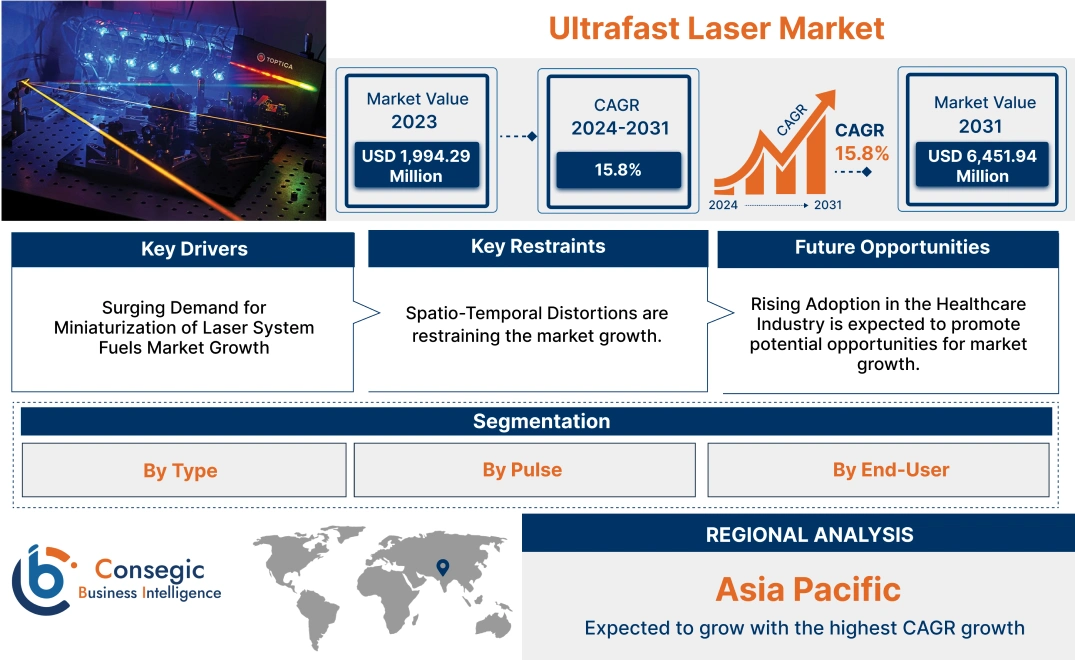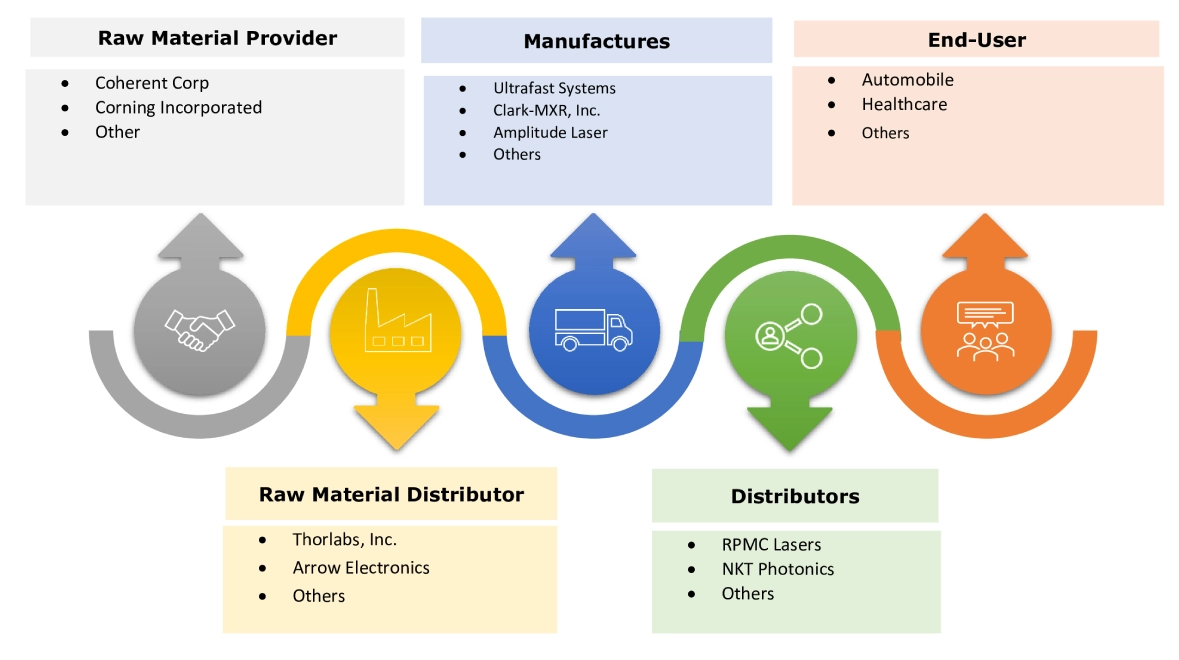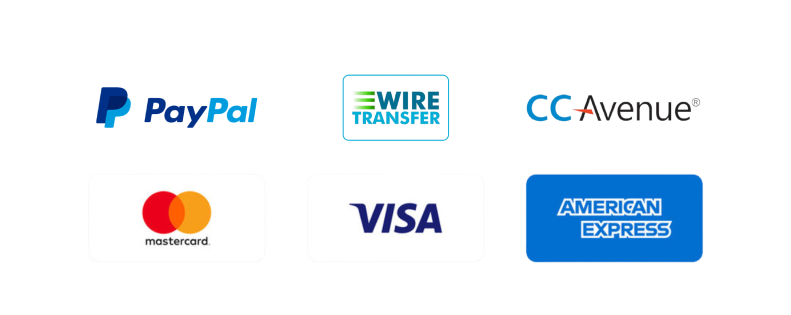Ultrafast Laser Market Size:
Ultrafast Laser Market size is growing with a CAGR of 15.8% during the forecast period (2025-2032), and the market is projected to be valued at USD 6.31 Billion by 2032 from USD 2.26 Billion in 2024. Additionally, the market value for the 2025 attributes to USD 2.56 Billion.
Ultrafast Laser Market Scope & Overview:
Ultrafast lasers, also known as ultrashort pulse lasers, are a specialized class of lasers that emit exceptionally brief, high-intensity pulses of light, typically ranging from picoseconds (10−12 seconds) to femtoseconds (10−15 seconds). These concentrated bursts or energy are generated through techniques such as mode-locking in turn creating a chain of ultrashort pulses. Due to features it possesses such as their high peak power, precise control, and ability to induce localized excitation, ultrafast lasers are highly suitable for diverse applications, including consumer electronics, healthcare, and the automotive industry.
Ultrafast Laser Market Dynamics - (DRO) :
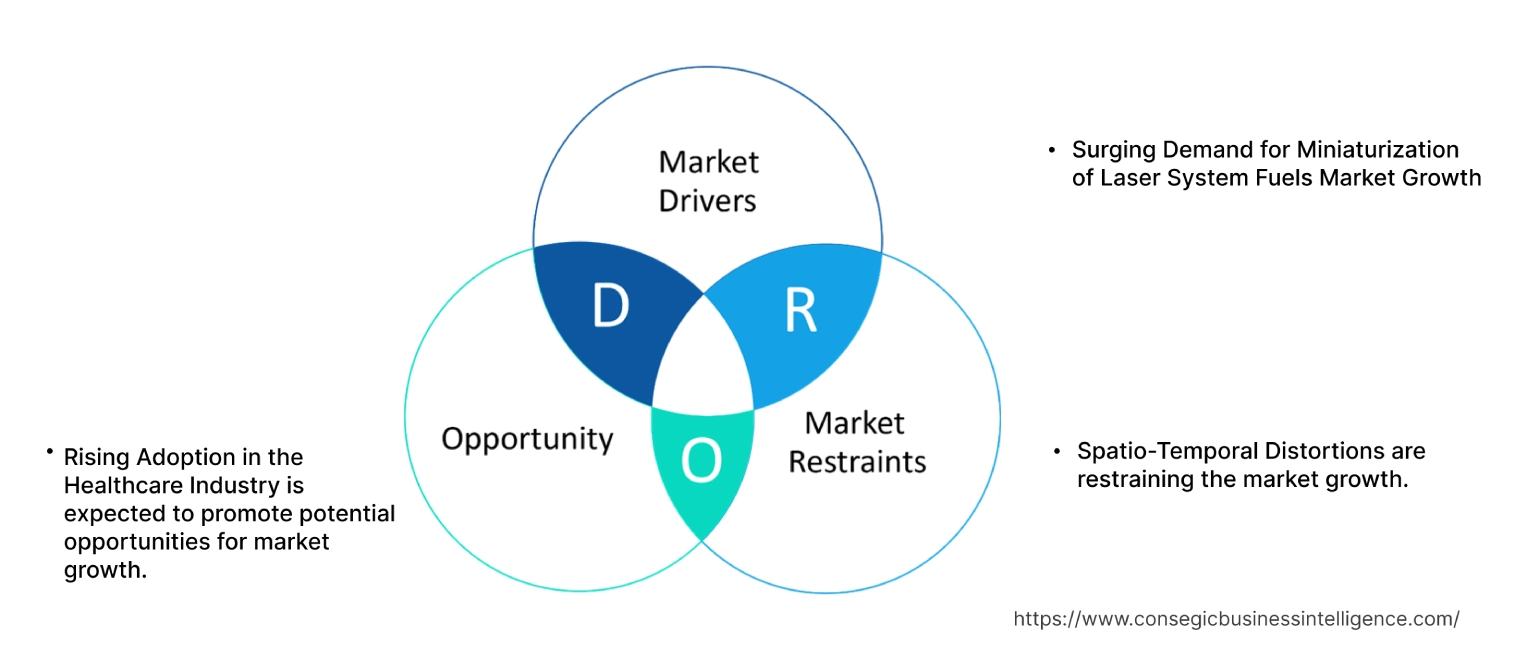
Key Drivers:
Increasing Miniaturization is Accelerating Ultrafast Laser Market Expansion.
Historically laser systems were large, and laboratory bounded. However, these lasers are now becoming significantly more compact, robust, and user-friendly. These smaller devices are helping in the easier integration into industrial production lines. They are also gaining traction in medical devices and portable scientific instruments. The reduced range of lasers also leads to lower system costs and easier handling. It has also increased reliability. This is making ultrafast laser technology more appealing to a wider range of industries such as medical devices. Moreover, consumers are increasingly seeking smaller and powerful devices. This requires such types of lasers and consequently manufacturers are partnering to launch new products.
For instance,
- In 2023, Edmund Optics partnered with Chromacity to launch a range of simple and compact ultrafast laser systems, thus positively impacting ultrafast laser market trends.
Overall, increasing miniaturization is significantly boosting the ultrafast laser market expansion.
Key Restraints :
Growing Commercialization of Alternatives is Hampering the Ultrafast Laser Market Demand.
The market faces hurdles from the substitutes available in the market. For instance, CO2 lasers are widely used in laser technology. These lasers are beneficial in offering high power output. They are highly effective for cutting and welding thicker metals and non-metals. This includes wood, plastics, and fabrics among others, where a larger heat-affected zone is acceptable. They also provide excellent efficiency and are generally cost-efficient. Moreover, mechanical machine remains most utilized for many large-scale tasks, where also less precision is required. This machine is helpful in creating complex 3D geometries. They handle very thick and bulky materials where laser processing is impractical or too slow. There is also established infrastructure of these alternatives and generally requires less expertise, and a lower initial investment compared to high-tech laser systems. Hence, the growing commercialization of alternatives is hampering the ultrafast laser market demand.
Future Opportunities :
Rising Adoption in Healthcare is Expected to Increase Ultrafast Laser Market Opportunities.
Ultrashort pulse lasers are revolutionizing the medical procedures and diagnostics. In dermatology they are used for skin resurfacing, tattoo removal, and scar treatment. They are beneficial in providing superior results and faster healing. Moreover, they are also used in minimally invasive surgical incisions in various fields. It reduces scarring, bleeding and enhances patient outcomes. Additionally, they are widely used in procedures such as LASIK eye surgery, for creating precise corneal flaps and in cataract surgery. They are also advantageous in softening lenses with minimal thermal damage to surrounding delicate eye structures. These factors have positively influenced ultrafast laser market trends.
For instance,
- In 2024, ViaLase received CE Mark for its femtosecond laser for the treatment of glaucoma, creating potential for the market.
Overall, rising adoption in healthcare is expected to increase the ultrafast laser market opportunities.
Ultrafast Laser Market Segmental Analysis :
By Type:
Based on type, the market is categorized into fiber lasers, titanium-sapphire lasers, dye lasers, mode-locked lasers, and others.
Trends in Type:
- Growing trend of using fiber lasers in multiple industries due to their ruggedness, efficiency, and excellent beam quality.
- Usage of mode-locked lasers for high-speed optical communications and precise scientific instruments is also a rising trend.
The fiber lasers segment accounted for the largest market share of 29.83% in 2024.
- In fiber lasers, laser light is generated within an optical fiber doped with the presence of rare-earth elements. This includes ytterbium and erbium among others.
- These lasers are beneficial in providing excellent conversion of electrical to optical properties.
- They produce high-quality beams, which are generally near-diffraction-limited. This is crucial aspect for precise micromachining.
- Companies are increasingly involved in strategic partnerships and collaborations. It is to expand their market reach and product portfolios. This is driving the segment.
- For instance, in 2023, RPMC Lasers Inc. partnered with fluence technology for the distribution of RPMC ultrafast fiber laser portfolio and other devices.
- Overall, as per the market analysis, the aforementioned factors are driving a segment in the ultrafast laser market growth.
The mode-locked lasers segment is expected to grow at the fastest CAGR over the forecast period.
- Mode-locked lasers utilize a special technique called mode locking, which generate ultrafast pulses of light.
- These lasers harmonize the phase relationship between various longitudinal modes, instead of emitting continuous waves.
- They are helpful in precise material processing and the study of ultrafast phenomena.
- Moreover, the short pulses of these lasers are used applications such as ultrafast spectroscopy and optical coherence tomography (OCT).
- Additionally, they are designed to deliver highly stable pulses. This is essential for challenging scientific and industrial applications. All these benefits are driving its increased usage.
- According to market analysis, the aforementioned factors will drive the segmental share in the ultrafast laser market growth.
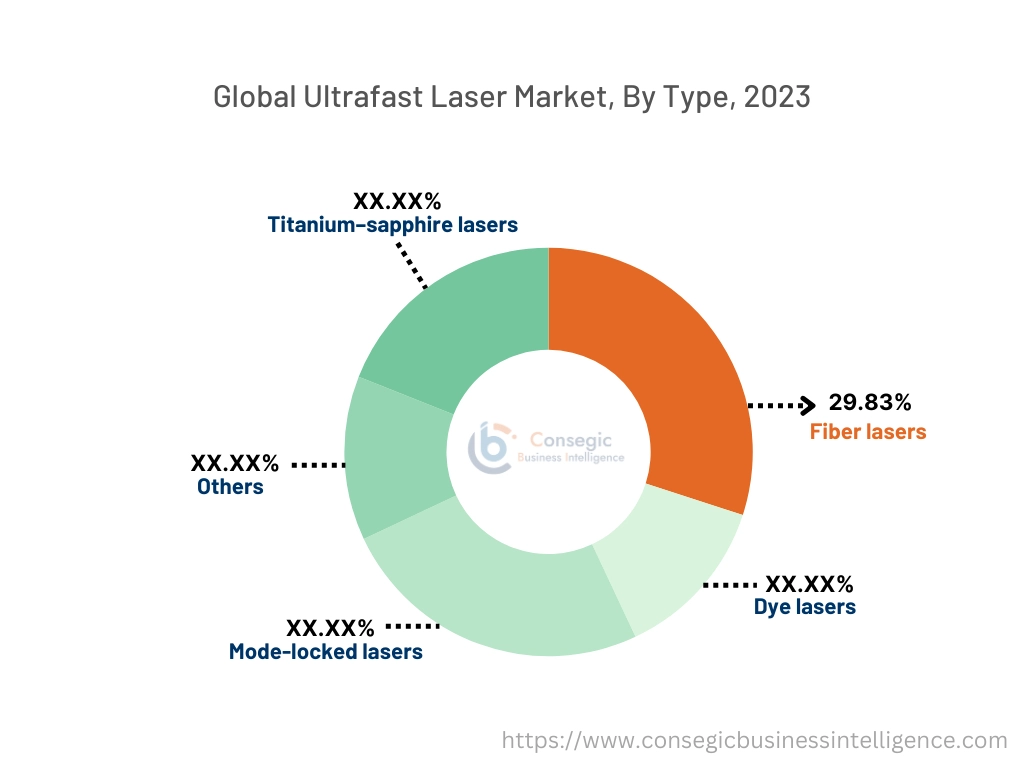
By Pulse:
Based on pulse, the market is categorized into femtosecond and picosecond.
Trends in Pulse:
- There is a strong focus on making femtosecond laser systems smaller and more robust. This will help with easier integration into portable devices.
- Manufacturers are continuously pushing for higher average power. This will help in enabling faster processing speeds.
The femtosecond segment accounted for the largest market share in 2024 and is expected to grow at the fastest CAGR over the forecast period.
- Femtosecond lasersemit optical pulses within certain durations. This includes the range of 10⁻¹⁵
- These pulses are incredibly short. This is helpful in delivery of laser energy before the heat spread to its surrounding material.
- This results in extremely clean cuts. They provide minimal heat and ensure no micro-cracks or debris at present. It is crucial for processing delicate sensitive materials.
- They provide precise processing to multiple materials, even they are effective on traditional hard materials as well. This includes glass, ceramics, and polymers among others.
- Manufacturers are launching new products to cater for industry’s demand for lasers, which are more accurate, precise and efficient, thus driving the segment share.
- For instance, in 2024, TeraXion launched VINCI-1064 as a femtosecond fiber laser. It is designed for applications such as terahertz generation, two-photon microscopy, and two-photon polymerization.
- Overall, as per the market analysis, the aforementioned factors are driving segmental growth in the ultrafast laser industry.
By End-User:
Based on end-use, the market is categorized into consumer electronics, healthcare, automotive, aerospace & defense, and others.
Trends in End-Use
- The growing shift towards electric vehicles is driving demand for ultrashort pulse lasers for precise battery cell and module manufacturing.
- Ultrashort pulse lasers are increasingly adopted in the precision manufacturing of complex parts, as they later improve the performance of aircraft systems.
The consumer electronics segment accounted for the largest market share in 2024.
- Ultrashort pulse laser is used for precision cutting and scribing of delicate materials used in multiple devices. This includes smartphone screens, OLED, and LCD panels among others.
- It ensures clean edges and prevents micro-cracks. They are also used in the manufacturing of tiny and intricate electronic components such as cameras and sensors.
- Moreover, these lasers are also crucial in silicon wafer dicing. They provide excellent micro-fabrication steps for producing advanced memory chips.
- Additionally, they are utilized in welding of dissimilar materials. They provide high precision without damaging underlying circuitry.
- As consumer demand for electronics is growing, the need for these lasers is growing.
- Overall, as per the ultrafast laser market analysis, the aforementioned factors are driving the segment in the market.
The healthcare segment is expected to grow at the fastest CAGR over the forecast period.
- The healthcare segment is emerging in the market. In dermatology, these ultrashort pulse lasers are used in cataract surgery for lens fragmentation. They enhance patient safety and recovery.
- Moreover, in minimal invasive surgeries, they reduce bleeding, improve healing, and minimize patient trauma.
- Additionally, they are crucial for manufacturing devices such as stents, catheters, and implants. They are helpful in ensuring the highest quality of biocompatibility. Ongoing research and development are creating potential for the segment.
- For instance, in 2024, the INRS team and McGill University Health Centre demonstrated that ultrafast laser technology presents potential for treating cancer.
- Thus, according to market analysis, the aforementioned factors will drive segmental growth for the forecasted years.
Regional Analysis:
The regional segment includes North America, Europe, Asia Pacific, the Middle East and Africa, and Latin America.
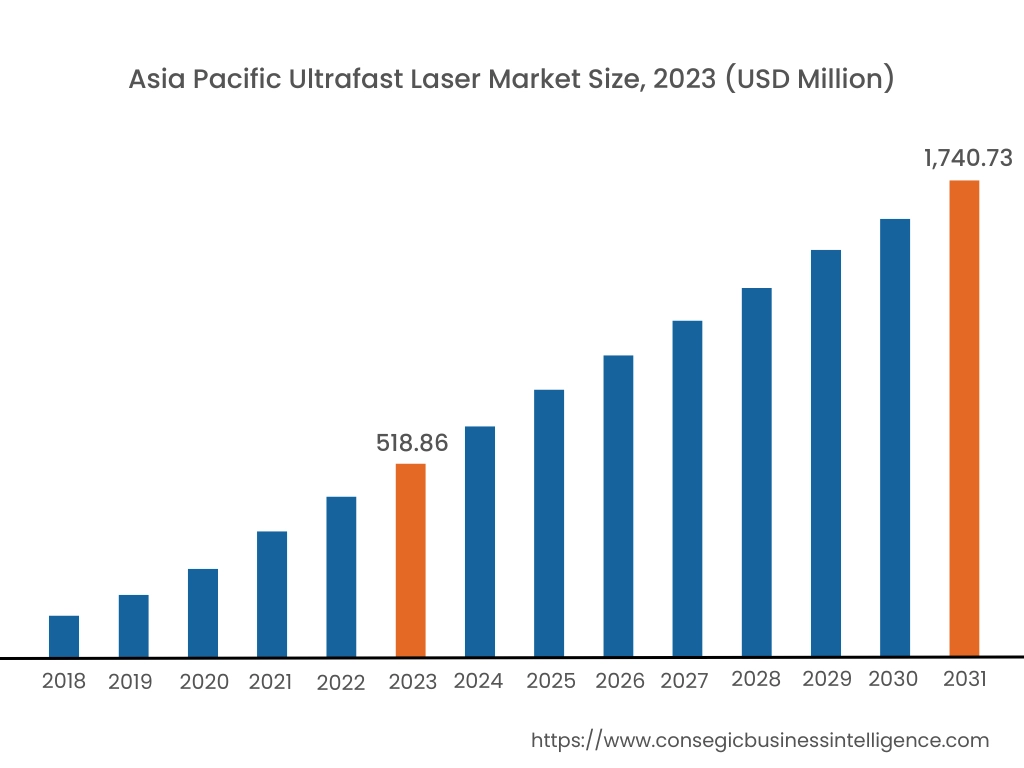
In 2024, Asia Pacific accounted for the highest ultrafast laser market share at 29.76% and was valued at USD 0.67 Billion and is expected to reach USD 1.84 Billion in 2032. In Asia Pacific, the China accounted for the ultrafast laser market share of 29.50% during the base year of 2024. There is increasing production of consumer electronics in the region. This is fueled by the increasing consumer demand for smartphones, tablets, wearables, and OLEDs among others. Ultrafast laser is critical tool for cutting and scribing these delicate devices. They provide high precision and protect from thermal damage. Moreover, the government are also taking initiatives to increase the adoption of these lasers. Countries such as China, India, South Korea, and Taiwan leads the market.
For instance,
- In 2023, the Taiwan Ministry of Economic Affairs, collaborated with Lithuania for the development of an ultrafast laser technology research & innovation center in Tainan.
Overall, rising production of consumer electronics and government initiatives are driving the market in the region.
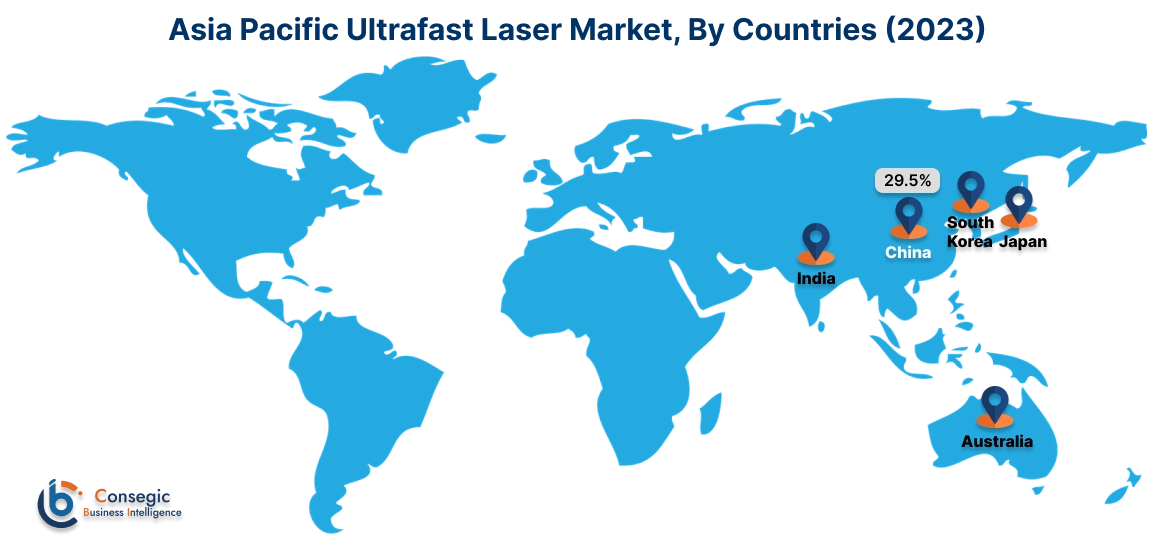
In North America, the ultrafast laser market is experiencing the fastest growth with a CAGR of 16.7% over the forecast period. The region is on the forefront of launching ultrashort pulse lasers with advanced technologies. Companies are developing lasers which are providing higher average powers and improvised beam quality. This is expanding the range of applications. Moreover, they are making lasers more compact and robust, which has increased reliability. These miniature devices have become important for integration into multiple industries such as medical. Additionally, robotics and control systems provide more seamless integration. This is boosting efficiency and accuracy.
Europe's ultrafast laser market analysis indicates that several key trends are contributing to its growth in the region. The region is a hub for automotive manufacturing. Moreover, there is increasing production of electric vehicles as well. This has increased the need for the ultrashort pulse lasers, as they provide precise processing to multiple materials. This helps in reducing weight and improve fuel efficiency. Additionally, European manufacturers are relying for the precise fabrication of intricate sensors. This includes LiDAR and cameras among others.
Middle East and Africa (MEA) market analysis indicates that there is robust growth in the healthcare sector of the region. MEA countries such as Saudi Arabia and UAE are pushing hospitals and clinics to equip diagnostic equipment with these ultrashort pulse laser as they enhance patient outcome. They are adopting these lasers for different minimal invasive surgeries, cancer treatments, and dermatology procedures. Moreover, they are promoting medical tourism. This attracts patients seeking advanced treatments, which include those enabled by this technology.
Latin America's region creates potential for the market. The aerospace and defense sector is growing rapidly in the region. This is driven by increasing geopolitical tensions and modernization initiatives. Ultrashort pulse lasers are becoming crucial tools for precisely manufacturing parts such as aircraft wings, drones (UAVs), and other defense systems. Moreover, the growing integration of advanced sensors and communication systems in defense platforms is further boosting the demand. These lasers are helpful in excellent surface modifications of materials. This improves strength-to-weight ratios for challenging defense applications.
Top Key Players & Market Share Insights:
The Ultrafast Laser market is highly competitive with major players providing products to the national and international markets. Key players are adopting several strategies in research and development (R&D) and product innovation to hold a strong position in the global Ultrafast Laser market. Key players in The Ultrafast Laser industry include-
- Thorlabs, Inc. (United States)
- Lumentum Operations LLP (United States)
- Amplitude Laser (United Kin)
- Edmund Optics (United States)
- Novanta Photonics (United States)
- Coherent Corp. (United States)
- IPG Photonics Corporation (United States)
- Newport Corporation (United States)
- Ultrafast Systems (United States)
- Clark-MXR, Inc. (United States)
Recent Industry Developments :
Product launches:
- In 2024, SuperLight Photonics launched SLP-0280 which is an ultrashort pulse laser with features such as 25 femtosecond pulse, ultra-stable, and small form factor.
- In 2023, MKS Instruments, Inc. launched the Spectra-Physics IceFyre FS IR200 laser, which is a femtosecond laser. The laser offers numerous benefits such as high performance and flexibility.
Mergers & Acquisitions
- In 2024, TroGroup acquired Luxinar, which is a manufacturer of laser systems in the UK. The acquisition aims to enhance technological leadership in the field of laser sources.
- In 2024, Hamamatsu Photonics K.K. acquired NKT Photonics, which is a leading supplier of high-performance fiber laser and other technology. The acquisition aims to accelerate the business in the fields of semiconductor, quantum, and medical.
Ultrafast Laser Market Report Insights :
| Report Attributes | Report Details |
| Study Timeline | 2019-2032 |
| Market Size in 2031 | USD 6,451.94 Million |
| CAGR (2024-2031) | 15.8% |
| By Type |
|
| By Pulse |
|
| By End-User |
|
| By Region |
|
| Key Players |
|
| North America | U.S. Canada Mexico |
| Europe | U.K. Germany France Spain Italy Russia Benelux Rest of Europe |
| APAC | China South Korea Japan India Australia ASEAN Rest of Asia-Pacific |
| Middle East and Africa | GCC Turkey South Africa Rest of MEA |
| LATAM | Brazil Argentina Chile Rest of LATAM |
| Report Coverage |
|
Key Questions Answered in the Report
How big is the Ultrafast Laser market? +
In 2024, the Ultrafast Laser market is USD 2.26 Billion.
Which is the fastest-growing region in the Ultrafast Laser market? +
North America is the fastest-growing region in the Ultrafast Laser market.
What specific segmentation details are covered in the Ultrafast Laser market? +
Type, Pulse and End-Use segmentation details are covered in the Ultrafast Laser market
Who are the major players in the Ultrafast Laser market? +
Thorlabs, Inc. (United States), Lumentum Operations LLP (United States), Coherent Corp. (United States), IPG Photonics Corporation (United States), and Newport Corporation (United States) are some major players in the market.
What are the key trends in the ultrafast laser Market? +
The ultrafast laser market is being shaped by several key trends including the development of exhaust gas sensors with the help of ultrafast laser and increasingly adopted in the manufacturing of aerospace components due to the integration of sensors for improving the lifespan of metal and other as well as rising adoption of picosecond laser in dermatology for facial photoaging and enlarged facial pores among others due to reduced thermal diffusion are the key trends driving the market.
